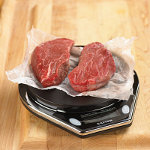 I am blatantly linking to this article on MSN. I know, I'm actually reading an article on MSN? It came from a link on Facebook to Lifehacker so I would say it has a good pedigree. The article makes a lot of sense too.
I am blatantly linking to this article on MSN. I know, I'm actually reading an article on MSN? It came from a link on Facebook to Lifehacker so I would say it has a good pedigree. The article makes a lot of sense too.http://money.msn.com/saving-money/how-to-eat-when-you-are-really-broke-weston.aspx
(Really, read this article. It's very good.)
Too busy to read it? Here's the Cliff Notes version:
If you are an America, you probably spend too much money per month on food. You go out to eat too often and when you don't go out to eat, most of the food you buy is over processed, not nutritious enough, and goes bad in your refrigerator, freezer, or pantry before you eat it.
Here are their recommendations, and they are all common sense:
1. Eat mostly at home
I think about a grilled cheese sandwich. In its simplest form, two slices of bread, a little butter, and two slices of American cheese. If you make that at home it will cost you less that $0.40. At most diners it's the cheapest sandwich on the menu at $2.00.
2. Skip the Processing
With all of my wife's allergies we have a general rule of thumb, if the ingredient list on the label has more than five items, it probably has been processed too much.
3. Demote Meat
Most dietitians recommend limiting meat portions to 3 ounces; I rarely follow this rule. Most cultures use meat as a flavoring and not the main component of a meal. If you purchase a pound of beef for $3.00 and have 2 - 8 ounce steaks, you have 2 - $1.50 meat servings. That same pound of beef can be cut up and used into a stir fry where it can be turned into 8 - 2 ounce $ 0.38 servings. OR skip meat altogether (Heavens NO!) for Lentils or Beans.
4. Promote Vegetables
Increase the amount of fresh seasonal and frozen vegetables. But try to avoid canned since it normally has been processed with too much salt and sugar.
5. Go for the Grains
Whole grains are very filling, full of fiber, and fairly inexpensive.
 6. Watch the Waste
6. Watch the WastePatrol your pantry. Watch for dates. Watch for rot.
7. Drop your Bad Habits
Reduce the amount of alcohol, tobacco, and soda you consume. I think that would also mean no more lattes at Starbucks every day.
 8. Get a Slow Cooker
8. Get a Slow CookerAlways a good idea. I also recommend getting a pressure cooker/canner, especially if you have a garden.
9. Cook Once, Eat Twice
Make enough for left overs. Good idea, but don't be afraid to take it a couple of steps further. Growing up, my Mom's most successful diet weight-loss and financially involved cooking all day every other Sunday. We would make 5 or 6 different main courses and then divided them into individual portions and freeze them. With different schedules throughout the week, we could both have home-cooked meals that were healthy and economical.
10. Learn to Love Lentils
The article points out that lentils are fast to cook and are packed pith protein. But other legumes are worth noting and cooking. In fact if you have the pressure cooker I mentioned in #8, a pound of beans takes an hour to cook. You can then can them yourself with less salt and processing than you would find at the supermarket. The article also mentions brown rice taking 40 minutes to cook. This is true, but you can take advantage of this by cooking things IN the rice, like lima beans or corn or chicken breasts or tomatoes, etc. etc.
11. Have Some Go-To Recipes
Ah! The ace up the sleeve. I have several including the All purpose cream of the vegetable in the freezer soup and grilled cheese. Or Shepherds Pie. Fast dinner when you get home beats going out to eat.
Ya know what? I think my article ended up being longer than the original!
Until next time, I wish you peace, love, and hollandaise sauce!












No comments:
Post a Comment